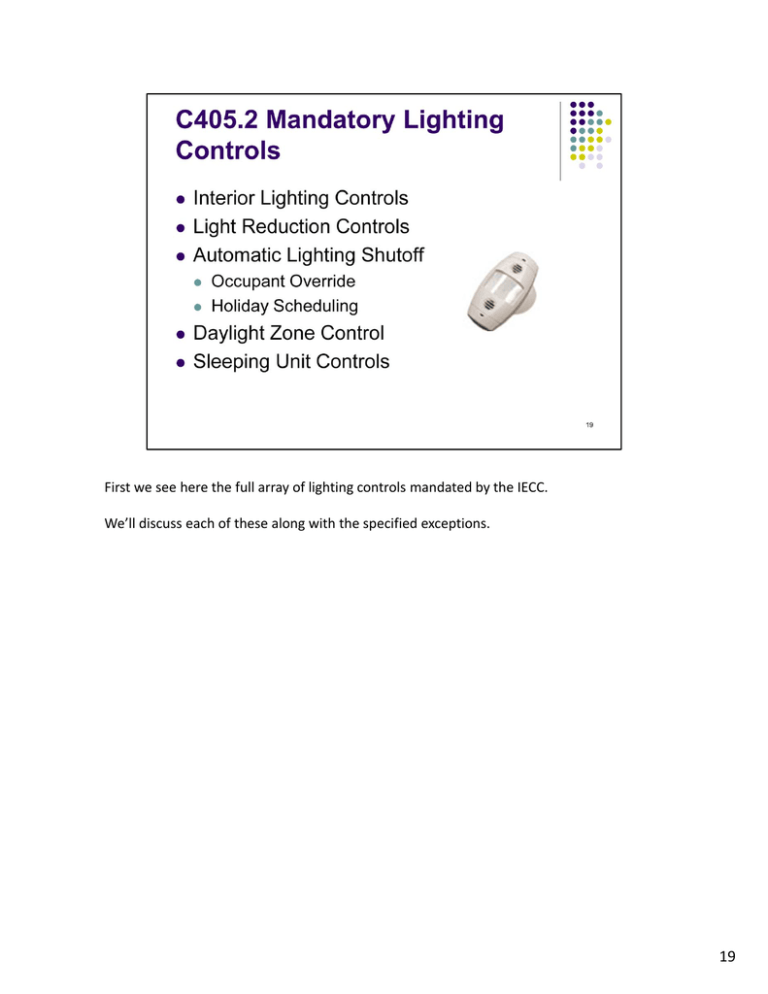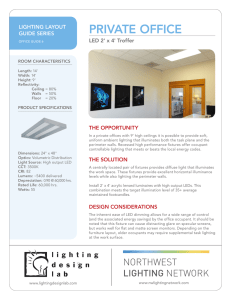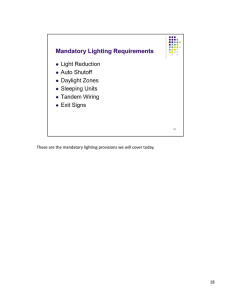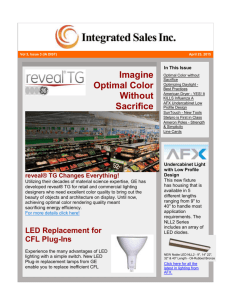Lighting Controls
advertisement

First we see here the full array of lighting controls mandated by the IECC. We’ll discuss each of these along with the specified exceptions. 19 Each area enclosed by walls or floor‐to‐ceiling partitions shall have at least one manual control for the lighting serving that area. The required controls shall be located within the area served by the controls or be a remote switch that identifies the lights served and indicates their status. Exceptions to this requirement include 1. Areas designated as security or emergency areas that must be continuously lighted. AND 2. Lighting in stairways or corridors that are elements of the means of egress. 20 Each area that is required to have a manual control shall also allow the occupant to reduce the connected lighting load in a reasonably uniform illumination pattern by at least 50 percent. Lighting reduction shall be achieved by one of the following methods or as approved by the code official: 1. All lamps and luminaires can be controlled as a single entity; OR 2. Use dual switching of alternate rows of luminaires, alternate luminaires or alternate lamps; OR 3. By switching the middle lamps of luminaires independently of the outer lamps when using three or four lamp luminaires; or by 4. Switching each luminaire or each lamp independently. ================================================================================= ==== Exceptions to this requirement include: 1. Areas that have only one luminaire. 2. Areas that are controlled by an occupant‐sensing device. 3. Corridors, storerooms, restrooms or public lobbies. 4. Sleeping unit (more details about this will be provided later in Section 505.2.3). 5. Spaces that use less than 0.6 watts per square foot. AND 6. Daylight spaces that comply with the section on daylighting controls 21 Now let’s talk about the requirement for auto shutoff of the lighting The lighting in all areas of a building shall be equipped with an automatic control device to shut off the lighting in those areas.. Exceptions to that include: • Emergency egress lighting • Lighting controlled by occupancy sensors =================================================== This automatic time switch will have an override switch that: • Permits manual operation, • Allows no more than 2 hours of override, and • Controls a max of 5,000 sq.ft. =================================================== However, in malls, arcades, auditoriums, single tenant retail spaces, industrial facilities and arenas: • Override can be over two hours if it is a captive key device, and • The override switch coverage may go up to 20,000 sq.ft instead of 5,000. 22 We see here what space types are required to use an occupancy sensor that is set to turn off the lighting after 30 minutes of vacancy. ===================================================== These occ sensors are required to be either manual on or auto on to no more than 50% lighting power except for the areas listed here; these are allowed to be full auto on. 23 Now let’s discuss daylight controls. We first need to define what the IECC means by a ‘daylight zone’. Or, more exactly, the area of a daylight zone: First, let’s look at the official definition of a daylight zone under skylights. The area under skylights whose horizontal dimension, in each direction, is equal to the skylight dimension in that direction plus either the floor‐to‐ceiling height or the dimension to a ceiling height opaque partition, or one‐half the distance to adjacent skylights or vertical fenestration, whichever is least. ======================================================================== Now let’s look at a daylight zone adjacent to vertical fenestration. The design needs to document the area adjacent to vertical fenestration which receives daylight through the fenestration. For purposes of this definition and unless more detailed analysis is provided, the daylight zone depth is assumed to extend into the space a distance of 15 feet or to the nearest ceiling height opaque partition, whichever is less. The daylight zone width (that is the dimension parallel to the fenestration) is assumed to be the width of the window plus 2 feet on each side, or the window width plus the distance to an opaque partition, or the window width plus one‐half the distance to adjacent skylight or vertical fenestration, whichever is least. Let’s see if an example will make this more clear … 24 Here we see a simple, rectangular room with: A small skylight in the center, 3 windows on the west wall and An L‐shaped ceiling‐height partition on the left. Let’s now look at the resultant daylight zones: 25 On the left, in green, we see the daylight zones from the windows: •In depth, they extend out from the windows 15’ (G1) •Or to the ceiling height partition (G2), whichever is the least •In width, they go out 2’ (G3) or they until hit the partition (G4), whichever is the least On the right, in red, we see the daylight zone under the skylight; it extends: •(R1) out a distance equal to the ceiling height or: •(R2) To the ceiling height partition or •(R3) Half way to the windows (whichever is the least) 26 The lights in the daylight zone must be controlled independently of general area lighting and be controlled in accordance with either Section C405.2.2.3.1 or Section C405.2.2.3.2. ======================================================= Each daylight control zone shall not exceed 2,500 square feet. ======================================================== Contiguous daylight zones adjacent to vertical fenestration are allowed to be controlled by a single controlling device provided that they do not include zones facing more than two adjacent cardinal orientations (i.e., north, east, south, west). ======================================================== Daylight zones under skylights more than 15 feet from the perimeter must be controlled separately from daylight zones adjacent to vertical fenestration. =================================================== Exception: Daylight zones enclosed by walls or ceiling height partitions and containing two or fewer light fixtures are not required to have a separate switch for general area lighting. 27 Manual controls shall be installed in daylight zones unless automatic controls are installed in accordance with Section C405.2.2.3.2. 28 Set‐point and other controls used to calibrate the lighting control device shall be readily accessible. ============================================================ The daylighting control device shall be capable of automatically reducing the lighting power in response to available daylight by either one of the following methods: ============================================================== 1. Continuous dimming using dimming ballasts and daylight‐sensing automatic controls that can reduce the power of general lighting in the daylighted zone continuously to less than 35% of rated power at maximum light output. OR =================================================================== 2. Stepped dimming using multi‐level switching and daylight‐sensing controls that can reduce lighting power automatically. The system shall provide a minimum of two control channels per zone and be installed in a manner such that at least one control step is between 50% and 70% of design lighting power and another control step is no greater than 35% of design power. 29 Where multi‐level lighting controls are required by this code, the general lighting in the daylight zone shall be separately controlled by at least one multi‐level lighting control that reduces the lighting power in response to available daylight. ===================================================================== Where the daylighted illuminance in the space is greater than the rated illuminance of the general lighting of daylight zones, the general lighting shall be automatically controlled so that its power use is no greater than 35% of its rated power. ====================================================================== The multi‐level lighting control shall be located so that calibration and set point adjustment controls are readily accessible and separate from the light sensor. 30 Let’s now talk about sleeping units by first defining what a sleeping unit is. – you can see when you read the definition a couple of key points (1) If the space has both bathroom fixtures and kitchen facilities, it is no longer just a sleeping unit, and (2) if a space otherwise fits this definition but is part of a ‘dwelling’ unit, then it is not a sleeping unit. A ‘dwelling unit’ is a single unit providing complete independent living facilities for one or more persons including permanent provisions for living, sleeping, eating, cooking and sanitation. ======================================================================= Now let’s discuss what lighting controls are required in such spaces. Sleeping units in hotels, motels, boarding houses or similar buildings shall have at least one master switch at the main entry door that controls all permanently wired luminaires and switched receptacles. Now let’s discuss a couple of mandatory requirements not related to controls. 31




